Executive Summary
Online reviews are commonly given and used by consumers across many industries, from finding a good restaurant in a new town to reviewing a lawn care service provider. Nonetheless, fewer than 10% of SEC-registered investment advisers report using them, even though the SEC’s updated investment adviser marketing rule allows financial advisors to proactively encourage testimonials (from clients), use endorsements (from non-clients), and highlight their own ratings on various third-party review sites. Which suggests that advisers have an opportunity to leverage the power of online reviews, which can act as "evergreen referrals" and drive more prospects to seek out the firm’s services, all while adhering to their firm’s compliance requirements.
While some advisors might be concerned that reviews they encourage clients to make on the firm’s Google Business Profile could be seen as advertisements (creating additional compliance requirements), the language of the rule (and the SEC’s stated intent behind it) suggests that by providing all clients an equal opportunity to leave candid feedback on a Google Business Profile would not in and of itself turn that content into an advertisement (unless the content was later endorsed or approved by the adviser). However, selectively asking a subset of clients for testimonials, or guiding their responses to encourage more positive content (involving themselves in the preparation of the content), would likely result in the content being considered a communication of the adviser, potentially rendering it an advertisement subject to the disclosure and compliance requirements of the marketing rule.
Even though the updated marketing rule has enhanced advisers’ ability to leverage online reviews, some advisers might wonder whether clients will actually leave reviews (and, if, so, whether they will be positive). However, an analysis of thousands of Google reviews from financial advisory firms around the country shows not only that clients are willing to leave reviews (particularly if the firm has a proactive strategy for review generation), but also that firms with the most reviews tended to have higher than average ratings for advisory firms overall. Further, advisers tend to have higher ratings than businesses in other industries (perhaps reflecting the financial planning industry’s high retention rates and ability to make a difference in clients’ lives!).
To create an effective (and compliant) Google review strategy, a starting point for advisers is to update their Form ADV to reflect the use of testimonials and their Policies & Procedures to govern their approach to collecting, approving, and sharing testimonials. Next, by taking a proactive approach to reinforcing where they add value (e.g., because the most enthusiastic testimonials related to clients feeling like their adviser was delivering a personalized plan, advisers who address client concerns directly and make them feel a part of the process could generate more positive reviews). Further, advisers can potentially reduce the number of negative reviews received by ensuring that prospect and client relationships that do not work out (e.g., when a prospect does not meet the firm’s asset minimum) are handled respectfully (e.g., by referring the prospect to another advisor who might be able to better meet their needs) so that the individual does not feel compelled to leave a negative review.
Ultimately, the key point is that the SEC’s updated marketing rule provides advisers with the opportunity to boost their online reputation through the use of online reviews. And by taking a proactive approach (both to encouraging reviews and to meeting the rule’s requirements), advisers can potentially increase the number of inbound prospects they attract while remaining in compliance with the marketing rule’s requirements!
The SEC’s updated investment adviser marketing rule fundamentally changed the options available for advisers when communicating with prospects, with online testimonials representing a new avenue to build trust with prospects before they even land on an adviser’s website. Consider that 81% of consumers report using Google Reviews to evaluate businesses and that half of them trust those recommendations as much as a personal recommendation from a family member. Yet, despite overwhelming evidence of the influence of testimonials on consumer decision-making, fewer than 10% of SEC-registered firms report using them.
There have been a number of wonderful summaries of the Rule (including Chris Stanley’s on these very virtual pages), but less research on what actually happens when advisers take a proactive approach to online testimonials. We analyzed thousands of Google Reviews to shed more light on this, but given the persisting confusion, particularly as it relates to testimonials on third-party sites, it’s worth a brief re-visit of the regulations before diving into the data.
What The Regulations Say
When announcing the official adoption of the Rule, former SEC Chairman Jay Clayton wrote, “This comprehensive framework for regulating advisers’ marketing communications recognizes the increasing use of electronic media and mobile communications and will serve to improve the quality of information available to investors” (italics added for emphasis). While there are certainly a number of restrictions when it comes to an investment adviser’s proactive approach to using testimonials, beginning with the goal of providing better information to investors and potential clients is a useful lens for analyzing the text.
The Rule defines a testimonial as any statement by a current client:
(i) About the client or investor’s experience with the investment adviser or its supervised persons;
(ii) That directly or indirectly solicits any current or prospective client or investor to be a client of, or an investor in a private fund advised by, the investment adviser; or
(iii) That refers any current or prospective client or investor to be a client of, or an investor in a private fund advised by, the investment adviser.
Regarding advertisements, the Rule defines them as either of the following:
(1) Any direct or indirect communication an investment adviser makes to more than one person…that offers the investment adviser’s investment advisory services…; [or]
(2) Any endorsement or testimonial for which an investment adviser provides compensation, directly or indirectly…
What this means functionally is:
- Not all testimonials are advertisements;
- Advertisements may contain testimonials (if certain provisions are met); and
- In the case of compensated testimonials, the compensation would cause the resulting testimonial to be treated as an advertisement.
The distinction of when a testimonial is an advertisement is critical for advisers because it determines whether or not the adviser will be held accountable for the content and the clear and prominent display of the required disclosures.
If that isn’t confusing enough, there is another set of terms advisers should be cognizant of as it relates to testimonials: entanglement and adoption. These terms are used to describe when third-party content (including a testimonial) would be attributable to the adviser, thus causing it to be treated as an advertisement. Entanglement refers to the “extent to which the adviser has involved itself in the preparation of the information”, while adoption addresses “whether the adviser has explicitly or implicitly endorsed or approved the information after its publication.”
Entanglement becomes a particularly relevant concept in the context of requesting Google Reviews. The Rule states that merely “permitting all third-parties to post public commentary to the adviser’s website or social media page would not, by itself, render such content attributable to the adviser, so long as the adviser does not selectively delete or alter the comments or their presentation and is not involved in the preparation of the content… Conversely, if the investment adviser takes affirmative steps to involve itself in the preparation or presentation of the comments, to endorse or approve the comments, or to edit posted comments, those comments would be attributed to the adviser.”
What this suggests is that merely providing all clients an equal opportunity to leave candid feedback on a Google Business Profile would not in and of itself turn that content into an advertisement (unless the content was later adopted by the adviser…). However, selectively asking a subset of clients for testimonials, or guiding their responses to encourage more positive content (involving themselves in the preparation of the content), would likely result in the content being considered a communication of the adviser and potentially rendering it an advertisement subject to the disclosure and compliance requirements of the marketing rule. This would be consistent with (former) SEC Chairman Clayton’s stated goal of providing investors with more, unbiased information about potential advisers, in part through the inclusion of testimonials.
Are Reviews Relevant For Financial Advisers?
Over the last year, we’ve seen a great deal of discussion on topics ranging from what the SEC might mean by “facts and circumstances” (mentioned 43 times in the full text of the rule) to how advisers can time testimonial requests to maximize response rates (within 24 hours of an interaction).
But after talking with hundreds of advisers, marketers, and compliance officers, we’ve heard a more fundamental line of questioning and skepticism:
Financial advisers aren’t restaurants; it’s more personal. Will people really leave us a public review? And if they do, will it be good?
Perhaps the core driver for slow adoption has not been a conservative approach to compliance, but has instead been a lack of belief that the power of testimonials will translate to wealth management.
Studies from similarly high-consideration industries such as healthcare have shown an increasing volume and impact of testimonials in recent years, demonstrating consumers’ rising comfort in sharing reviews online. A proactive approach to generating reviews has also been shown to correlate with higher average ratings. Still, we heard a consistent refrain of, “Yes, but our industry is just different.”
So we looked at the data, analyzing thousands of Google reviews from hundreds of financial advisory firms around the country. We scraped reviews for businesses by using “financial advisor” in local search in the top 200 most populous cities, and then we manually refined the list by removing financial consultants, tax preparers, and other businesses that would not fall under the jurisdiction of the SEC, FINRA, or a local regulatory authority.
We found compelling evidence that financial advisers can indeed generate a meaningful quantity of Google reviews and also uncovered actionable insights regarding the type of interactions that lead to the best reviews.
Yes, Clients Will Leave Their Adviser A Google Review
Given the relatively low clientele volume of a financial adviser’s office (relative to, say, a restaurant), it was not surprising to see many firms with very few reviews. We focused our analyses on locations with at least 1 review, yet the median number of reviews for locations studied was still only 2. However, 15% of firms had 10 or more reviews, and the top 0.7% of firms had 100 or more reviews!
So while the majority of firms have relatively few reviews, a small subset have demonstrated success in generating significant review volume: 77% of all the reviews analyzed were posted to 20% of the Google Business Profiles. This suggests that some firms have obviously cracked the code when it comes to generating more reviews. One could suppose that these firms are simply fortunate to have more enthusiastic clients, but after several discussions with firms that find themselves near the top of the list, it is clear that a proactive strategy for review generation is the primary driver.
One point of contention we’ve heard when it comes to testimonials in wealth management is that clients tend to be… wealthy, and thus may have privacy concerns related to leaving a review that may have their name attached. It is worth noting that 4 out of the top 10 firms we analyzed in terms of review volume boast more than $1B in AUM, and on average, 43% of their assets under management stem from HNW clients (according to their most recent ADV Filings). So while advisers focused on Ultra-HNW clients could face challenges in collecting public reviews (though we don’t have direct evidence), there is no reason to believe that firms serving the mass affluent have an excuse.
No, Asking For Reviews Isn’t A Recipe For Getting Bad Reviews
When looking at the long tail of firms with just a handful of reviews, there is a great deal of variance in the average ratings. A single high or low rating can dramatically influence – or define – a firm’s Google rating, but in aggregate, a clear trend emerges. The average rating for firms we studied was 4.56 (advisers can take heart that this is above the average Google business rating of 4.1) with a standard deviation of 0.9.
Firms with 11+ reviews, however, had an average rating of 4.82 with a standard deviation of 0.39. Firms with 25+ reviews had an average rating of 4.88 with a standard deviation of 0.27. And firms with 100 or more reviews boast a similar rating at 4.89 but with a tighter distribution (standard deviation of 0.16).
What this tells us is that advisers who are worried about receiving negative reviews if they proactively solicit them have reason to be more worried about what happens if they don’t. This tracks with psychological research from other industries. People who share customer service stories are more likely to share negative experiences, perhaps seeking catharsis. In terms of online reviews, without prompting, consumers are 2–3 times more likely to write about a negative experience than a positive experience.
Advisers Fare Better Than Other Industries When It Comes To Google Reviews
The general distribution of review ratings we found matches the J-curve that has been well-documented in online reviews for both products and brick-and-mortar businesses (with the J-shape representing the phenomenon that there tends to be a handful of reviews with a very low rating, a large number with a high rating, and relatively few in between). What is interesting – and is good news for financial advisers – is that the proportion of 5-star reviews in the financial advice industry is higher than in other industries. 5-star ratings comprise 80% of all Google reviews (excluding businesses without Google reviews), but represent 92% of the reviews in our data sample. Perhaps it is more than a coincidence that the 94% of 4- or 5-star ratings match up with the 94.6% retention rate in the industry?
What’s In A Bad Review?
Many advisers we’ve spoken with have voiced concerns that clients will take out frustrations about market downturns on their Google profiles, but this doesn’t seem to be the case. In fact, complaints about fees or portfolio performance were mentioned in only 11% of the 1-star reviews studied (and only 23 out of close to 4,400 total reviews analyzed).
The majority of these negative reviews were either blank or lacked sufficient detail to determine the cause of the feedback. Many of the others had to do with challenges getting in touch with advisers or dissatisfaction with the cadence/content of updates.
When it came to the negative reviews, what stood out most was that more than 20% of the 1-star reviews we analyzed came from non-clients. And this figure is most certainly understated as it only includes reviewers who self-identified as non-clients (for example, individuals who complained about receiving solicitation phone calls from advisory firms). Assuming some portion of the blank/non-specific reviews are from non-clients as well, it is reasonable to estimate that around 1/3 of all 1-star reviews stem from interactions with non-clients.
So what triggers these negative reviews? We’ve seen everything from complaints about an adviser littering to a firm failing to appropriately tip their DoorDash delivery drivers. Our personal favorite is dissatisfaction with a firm that sponsored a portion of a highway and failed to keep it adequately clean.
Many of the negative reviews, however, stemmed from more avoidable interactions. Several disgruntled reviewers mentioned advisers failing to show up for introductory Zoom meetings, failing to provide a proposal in the agreed-upon timeframe, or becoming dismissive once they discovered the prospect’s investable assets.
What’s In A Good Review?
So bad reviews aren’t about performance, but surely good reviews depend on portfolio returns, right?
Nope. In fact, only 1% of the 5-star reviews we analyzed cited performance or fees as the primary reason for the rating.
In total, almost 2/3 of 5-star reviews were either blank, lacked meaningful context, or were generic statements of praise. But a lot can be learned from the 5-star reviews that did provide specific feedback.
These reviews tended to fall in 1 of 4 categories:
- Relationship/Communication (18%): trust-building capabilities of the adviser and accessibility of their team. Clients often referenced feeling like family and exceptional interpersonal skills.
- Example: “He is perfect for this job because not only is he knowledgeable but also really cares about his clients. We are more than just customers to him. He treats us like family. Even our kids love Uncle Ben!!! He is always available and goes above and beyond to meet our financial planning needs.”
- Knowledge/Expertise (11%): technical capabilities of an adviser who helped them through a particularly complex life/financial decision. Reviews often referenced advisers who break down complex topics with ease, which translated to increased client confidence.
- Example: “Like an efficient and very capable team leader, [my advisor] coordinated with our bookkeeper, CPA, lawyer and another portfolio advisor - organized our investments and expedited complicated trusts. He explained what has been done and what still needs to be done in language I can understand (without making me feel stupid!).”
- Personalized Approach (8%): listening to the unique needs of the client before providing tailored investing strategies to reflect their goals. Reviews in this category often praised an adviser’s dedication to crafting plans based on a client’s feedback and belief that the firm does not use a one-size-fits-all approach.
- Example: “Anyone looking for unique and informed information that is customized to the goals of the client and not a cookie-cutter one-size-fits-all approach, would be well served to visit [my advisor].”
- Performance/Fees (1%): Making money. The smallest subset, this group highlighted an adviser’s superior returns as their primary reason for the accolade.
- Example: “…His stock picks seem to be ahead of what you hear on CNBC, and honestly, I haven't seen anyone on there that can beat his advice. We consider ourselves lucky that we attended one of their seminars and started working with them so long ago.”
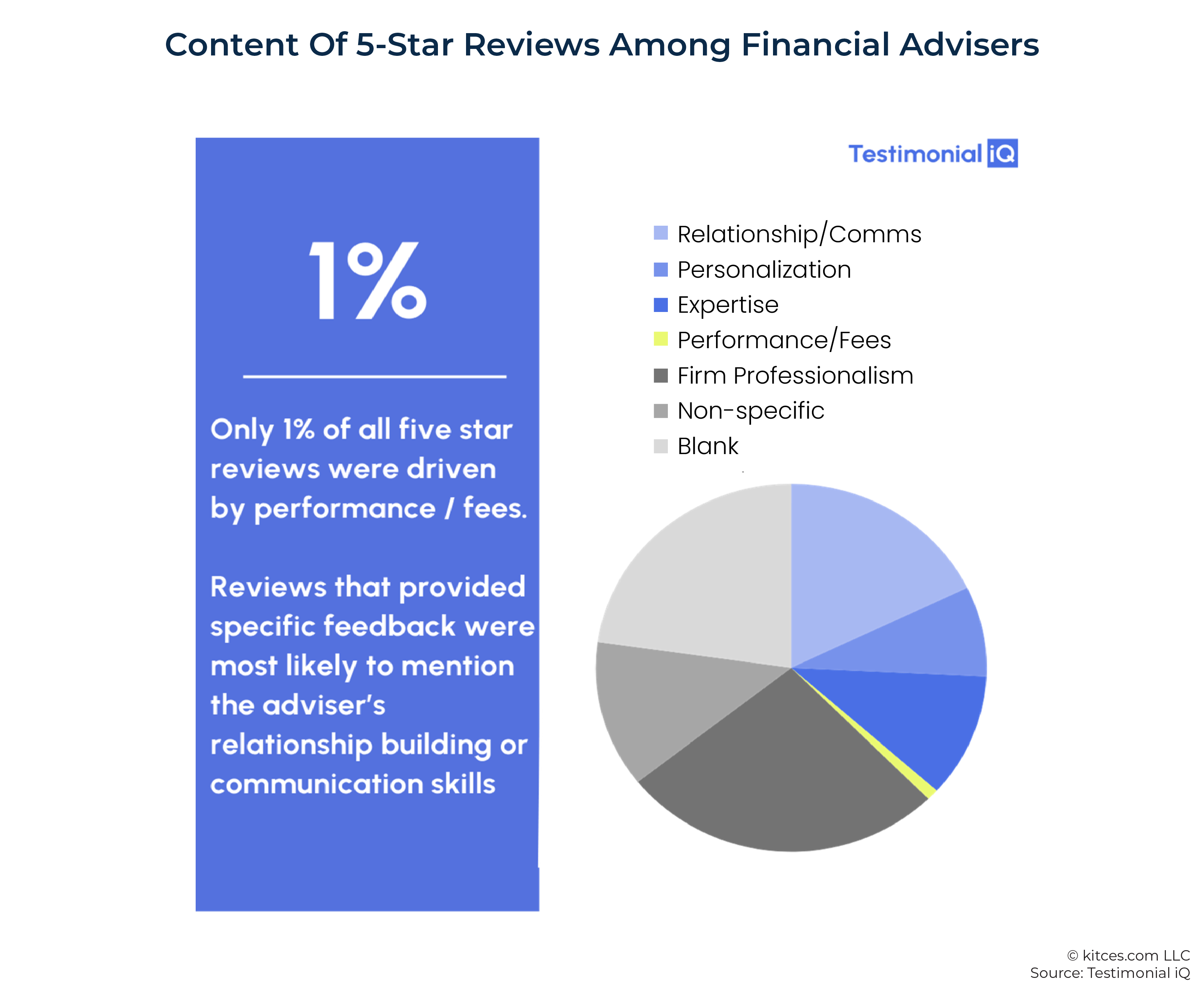 The content of reviews matters to Google, too. Google doesn’t necessarily display the most recent reviews first, but instead attempts to share the most relevant reviews with consumers, with length implied to be strongly correlated to relevance. When we look deeper at the 5-star reviews, the non-specific/generic reviews are shortest at approximately 160 characters. Reviews related to an adviser’s communication skills or expertise are longer at about 400 characters, and reviews highlighting the personalized approach of a firm average a whopping 572 characters!
The content of reviews matters to Google, too. Google doesn’t necessarily display the most recent reviews first, but instead attempts to share the most relevant reviews with consumers, with length implied to be strongly correlated to relevance. When we look deeper at the 5-star reviews, the non-specific/generic reviews are shortest at approximately 160 characters. Reviews related to an adviser’s communication skills or expertise are longer at about 400 characters, and reviews highlighting the personalized approach of a firm average a whopping 572 characters!
These results should provide advisers with some reassurance that clients perhaps understand their role better than they realize. Clients don’t praise advisers for beating the market; instead, they do it for giving them confidence where they had discomfort.
 What Can Advisers Do About It?
What Can Advisers Do About It?
For advisers who want to leverage client testimonials, understanding the relationship between testimonials and advertisements – and the resulting regulatory implications – is critical. Working together with their Compliance and Marketing teams can be the best way to establish a proactive testimonials program built around the regulatory requirements (shameless plug: my company, Testimonial iQ, makes software that can help with this part). It is critical for advisers to have their i’s dotted and t’s crossed before they wade into the waters.
For firms that choose to use testimonials in advertisements, in addition to updating Form ADV to reflect that use, firms should update their Policies & Procedures to govern their approach to collecting, approving, and sharing testimonials. Keep in mind that it isn’t enough to have a process that is unbiased; advisers also need a process that they can demonstrate is unbiased when examination time comes around. Correctly leveraging testimonials – especially Google reviews – requires upfront investment in time and resources, but advisers can think of the resulting content as evergreen referrals. With 165,000 searches for “financial adviser” each month on Google, this is an adviser’s best opportunity to shape their client’s first impression of them.
The following sections offer additional tips for advisers to create a testimonials process while remaining cognizant of the requirements of the SEC marketing rule.
Building A Process
Establishing a written process for collecting, reviewing, and sharing testimonials makes it easier to do at scale and is critical to maintaining regulatory compliance. The following list includes important actions for advisers to consider when developing their own process.
- The first step is to meet with Compliance to review current policies regarding testimonials. Align on what changes, if any, would be needed before gathering client feedback as well as what the collection process will look like.
- Create a tool to collect feedback. This could be an e-mail, a web form, or a software platform like ours. In addition to gathering feedback, it is important to have a mechanism to capture client permission to use that testimonial in marketing. Reviewing that feedback tool with Compliance helps ensure that it isn’t introducing bias. Something as simple as “we value your candid feedback” is a great place to start.
- Request testimonials from clients in a way that gives them all equal opportunity to provide feedback. Some advisers send out monthly requests as part of a client newsletter, while others choose to send them after each client meeting. As with anything else, store records of the process.
- Have Compliance review the testimonials before incorporating them into advertisements. If advisers place testimonials on their website, they are still accountable for the content. Keep in mind that if a client has opted to leave a testimonial on a third-party site such as Google, referencing that content would likely constitute adoption.
- Ensure that the appropriate clear and prominent disclosures are included in any advertisements that contain testimonials. That means the disclosure must be “at least as prominent” as the testimonial itself. Typically, disclosures look something like this:
This testimonial is from a current client. The client was not compensated in return for this testimonial and there are no material conflicts of interest.
Reinforcing The Adviser’s Value
When it comes to soliciting testimonials – especially Google reviews – coaching clients on the content or designing feedback requests in such a manner that clients would be more likely to share positive responses runs the risk of entanglement. This could result in testimonials being deemed advertisements of the adviser, requiring the adviser to take additional measures to ensure their compliance with the marketing rule.
What advisers can do, however – and should consider doing regardless of their use of testimonials – is to take a proactive approach to reinforcing where they add value. Bill Cates offers an excellent exercise for advisers to assess and communicate their value; our favorite part is to first ask, “What are the top 3 points of distinction that prospects can easily see, which differentiate me from my competitors?” And then to ask, “Do my current clients talk about their experience in a way that mirrors what I want prospects to know about me?” If not, dig in to find the disconnect.
Importantly, we discovered the most enthusiastic testimonials (and those with the longest word counts) related to clients feeling like their adviser was delivering a personalized plan. By practicing active listening and repeating back clients’ concerns and goals, advisers can explain how the plan they provided addresses those concerns while giving clients the opportunity to feel like a part of the process.
Communication That Can Mitigate Negative Reviews
Remember that a meaningful portion of reviews – especially negative ones – are unsolicited and can come from surprising interactions. Be cautious when turning down prospects that aren’t a good fit or when 'graduating' unprofitable clients. Finances are a sensitive topic, and if folks feel they are being looked down upon for their financial situation, it can result in a scathing review on a public forum.
For example, if an adviser typically works with clients with at least $500k in investable assets and has a discussion with a prospect who has significantly less, rather than leading the meeting with a conversation about minimum fees, the adviser can instead let them know that their expertise doesn’t align with their needs. Even better would be if the adviser follows up with a couple of potential recommendations for alternative firms the prospect might explore who do work with clients like them.
Don’t make assumptions about how and when clients want to hear from their adviser. In our study, some reviews raved about their once-a-year check-in, while others were excited about the steady stream of e-mail updates. When unsure, err on the side of overcommunication. We saw a grand total of zero reviews complaining about too much communication from the adviser (though we did see a few complaining about overly aggressive sales tactics).
The Upside Of Negative Reviews
Since advisers shouldn’t be coaching clients or selectively asking clients that they know will rave about their services, does that mean an adviser might get the occasional less-than-stellar review? Yes – and that’s OK!
First, take heart that people actually trust businesses with ratings of 4.2–4.5 more than they trust businesses with perfect 5-star ratings. Consumers use online reviews as a heuristic for trustworthiness, but when a business lacks any critical feedback, they become suspicious about the origin of the reviews.
Second, recognize this as an opportunity to repair a relationship with at-risk clients before they move their assets. One note of caution here: unlike in other industries where it is best practice to respond to every review (particularly negative reviews), there is a chance that doing so could trip the definition of adoption, resulting in the adviser’s Google Profile being deemed an advertisement. It’s best to contact the clients directly.
Contesting Fraudulent Reviews
Occasionally, internet trolls will leave reviews that are fake or that contain inappropriate content such as Personally Identifiable Information (PII), explicit language, or blatant misinformation. One adviser we chatted with recently had received a string of negative Google reviews from non-clients after a team member posted something disparaging about a rival collegiate football team!
These reviews should be reported to Google, but unless the adviser can prove the review violates Google’s terms of service, it can be very challenging to get them taken down. Keep in mind that anyone with a Google account can leave a review of an adviser, regardless of whether the adviser has claimed their profile. This is why many companies find it better to focus on generating a steady stream of authentic reviews: It’s the best way to dampen the impact of a fake review.
After decades of being barred from seeking testimonials, it’s understandable that many advisers feel uncomfortable with the thought of making clients a centerpiece of their marketing; however, for those that are on the fence, our research may provide some encouragement.
For those advisers that choose to solicit testimonials, the data suggests many of their clients will share their experiences enthusiastically and the resulting feedback will be generally very positive. Moreover, when it comes to Google reviews, because the industry average review volume is so low (due to decades of prohibitions), it takes relatively few to stand out. This means that advisers who start today may enjoy an advantage in attracting the increasing number of prospects who begin their search for financial advice online!


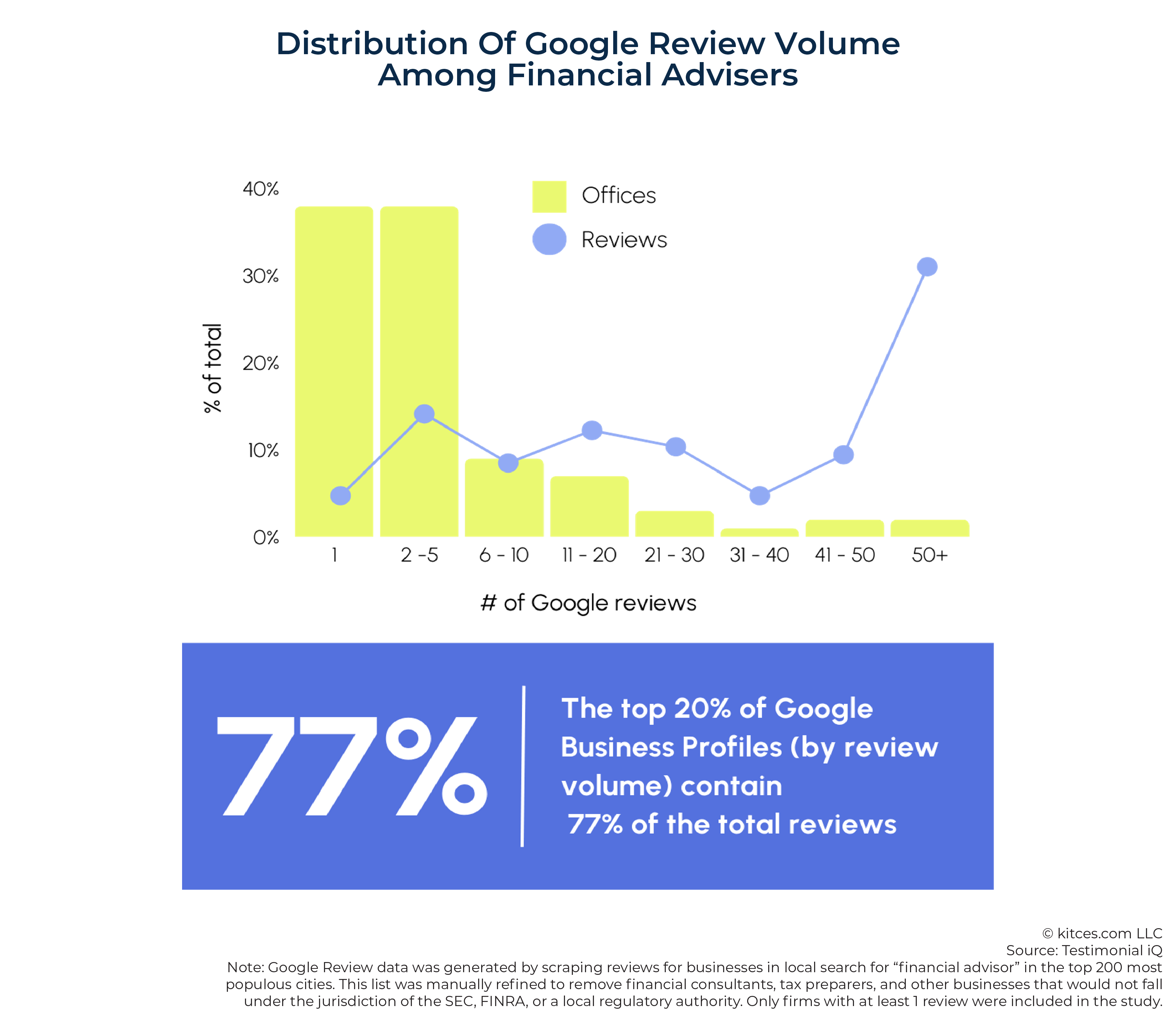
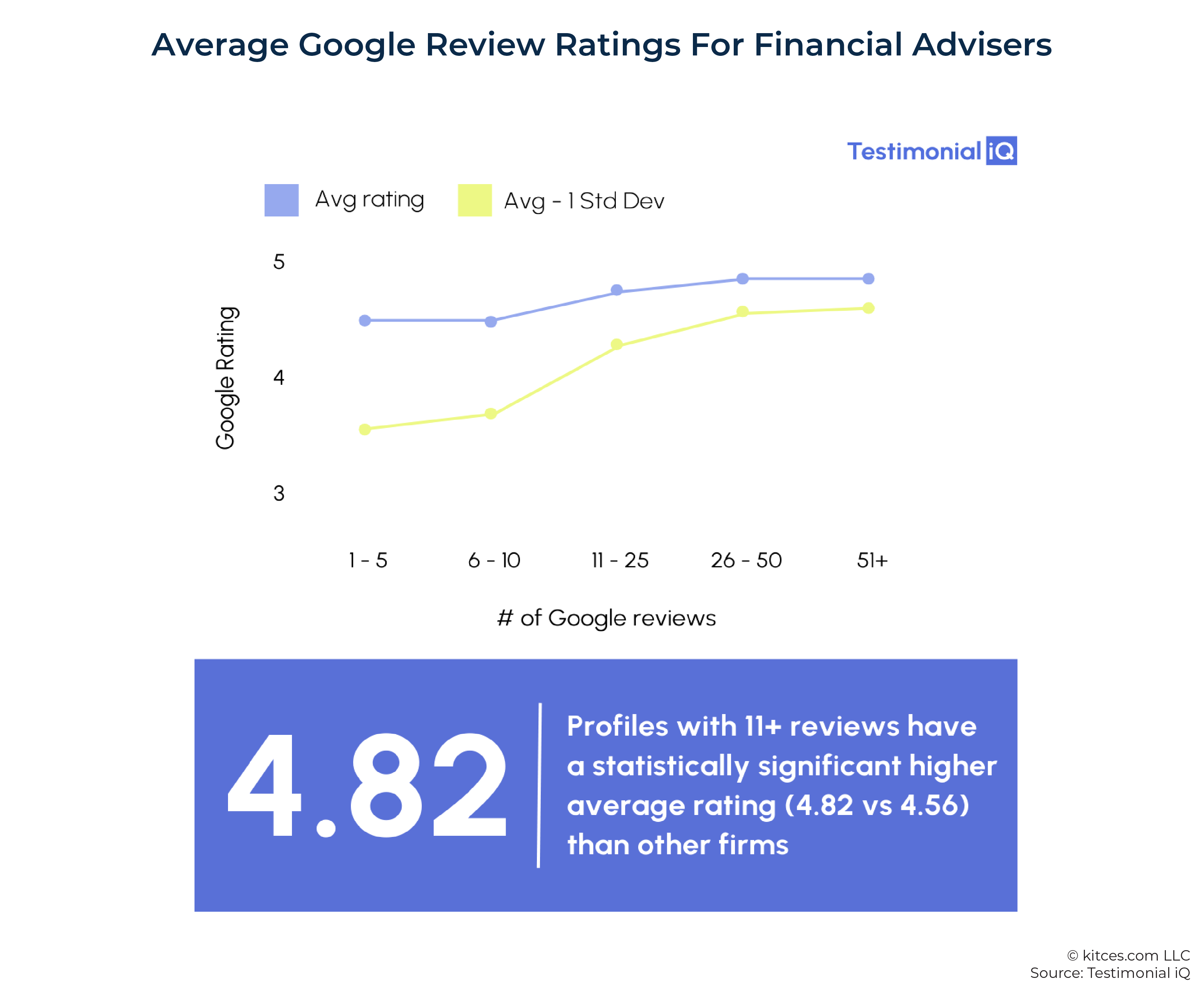
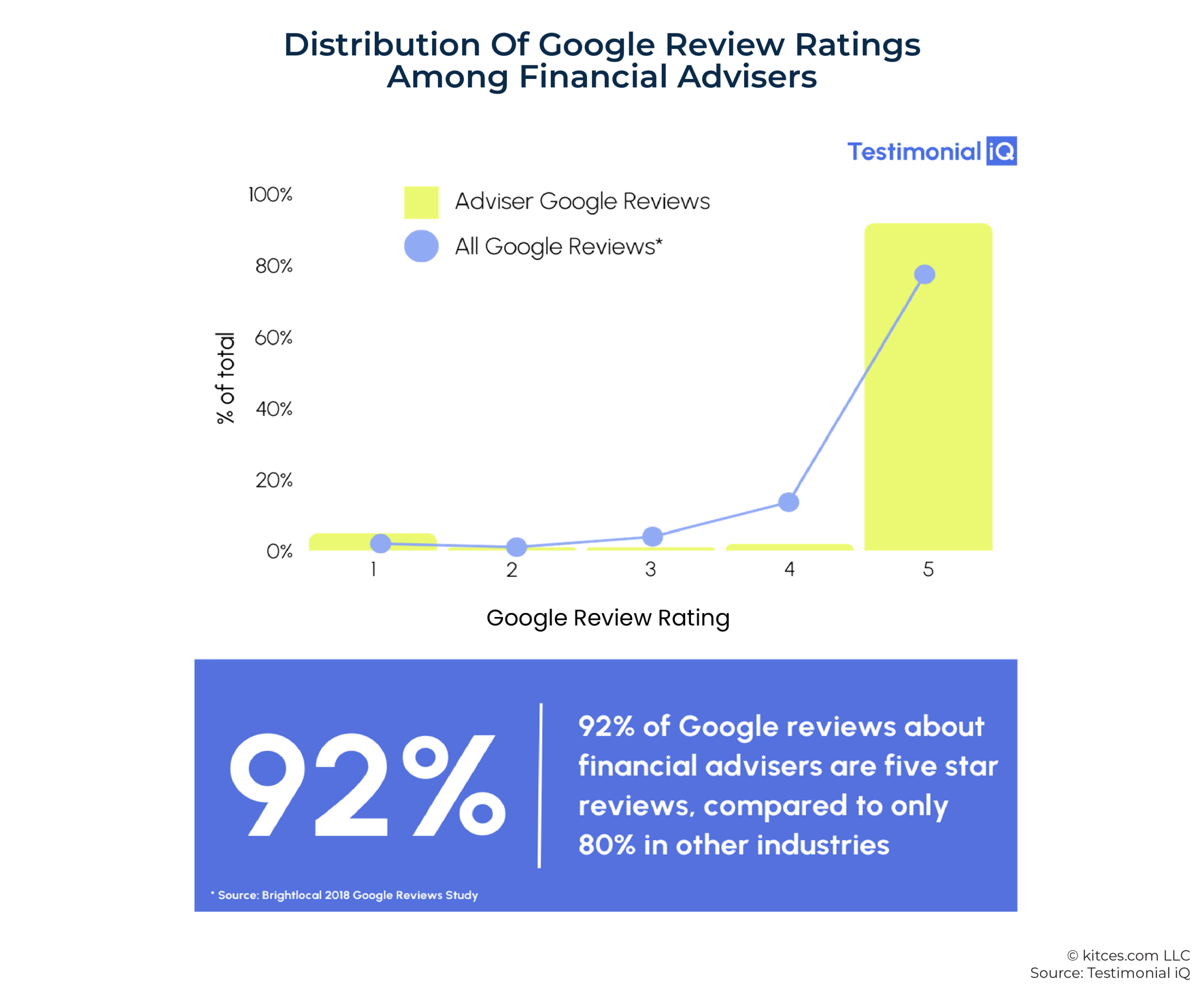
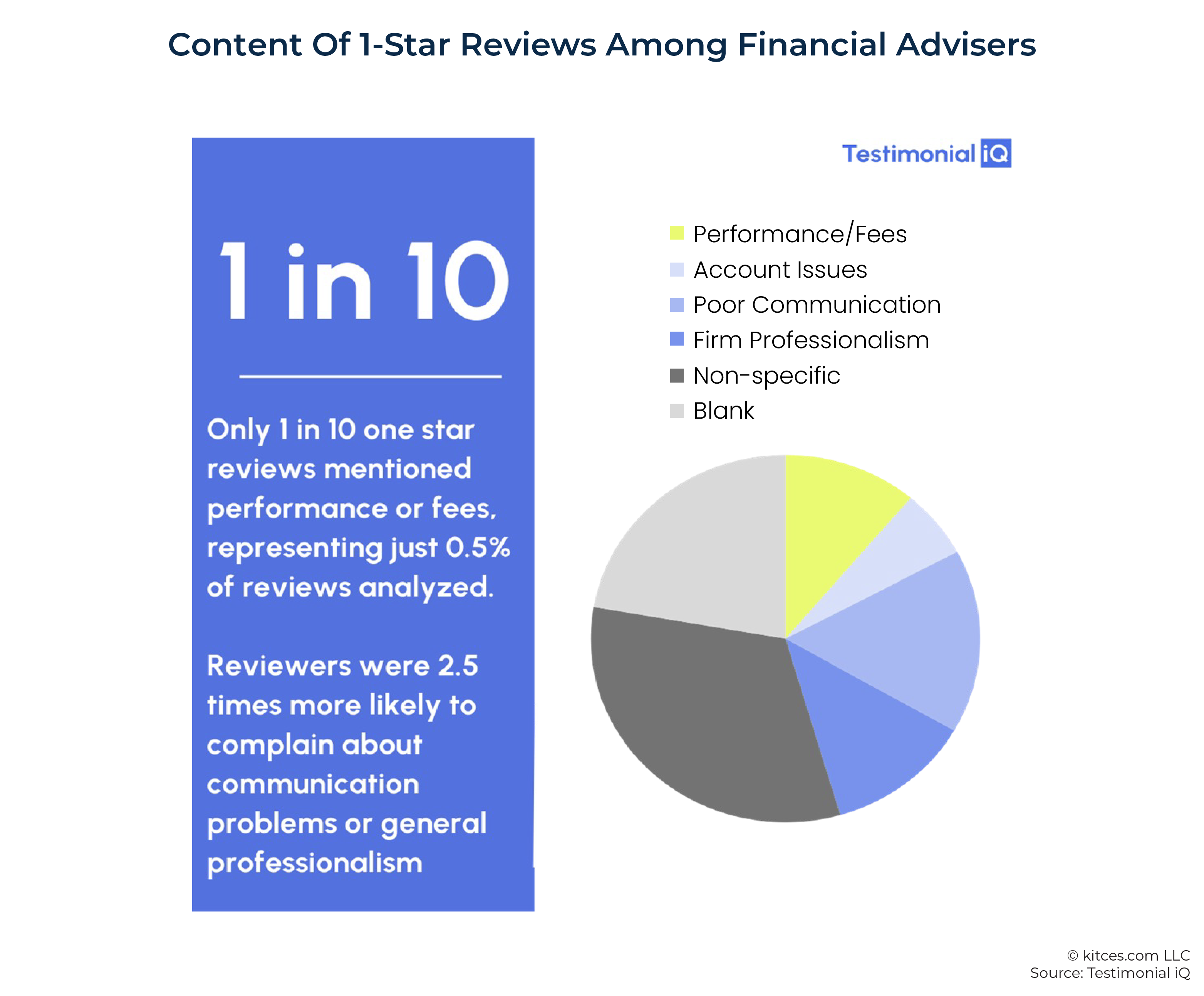
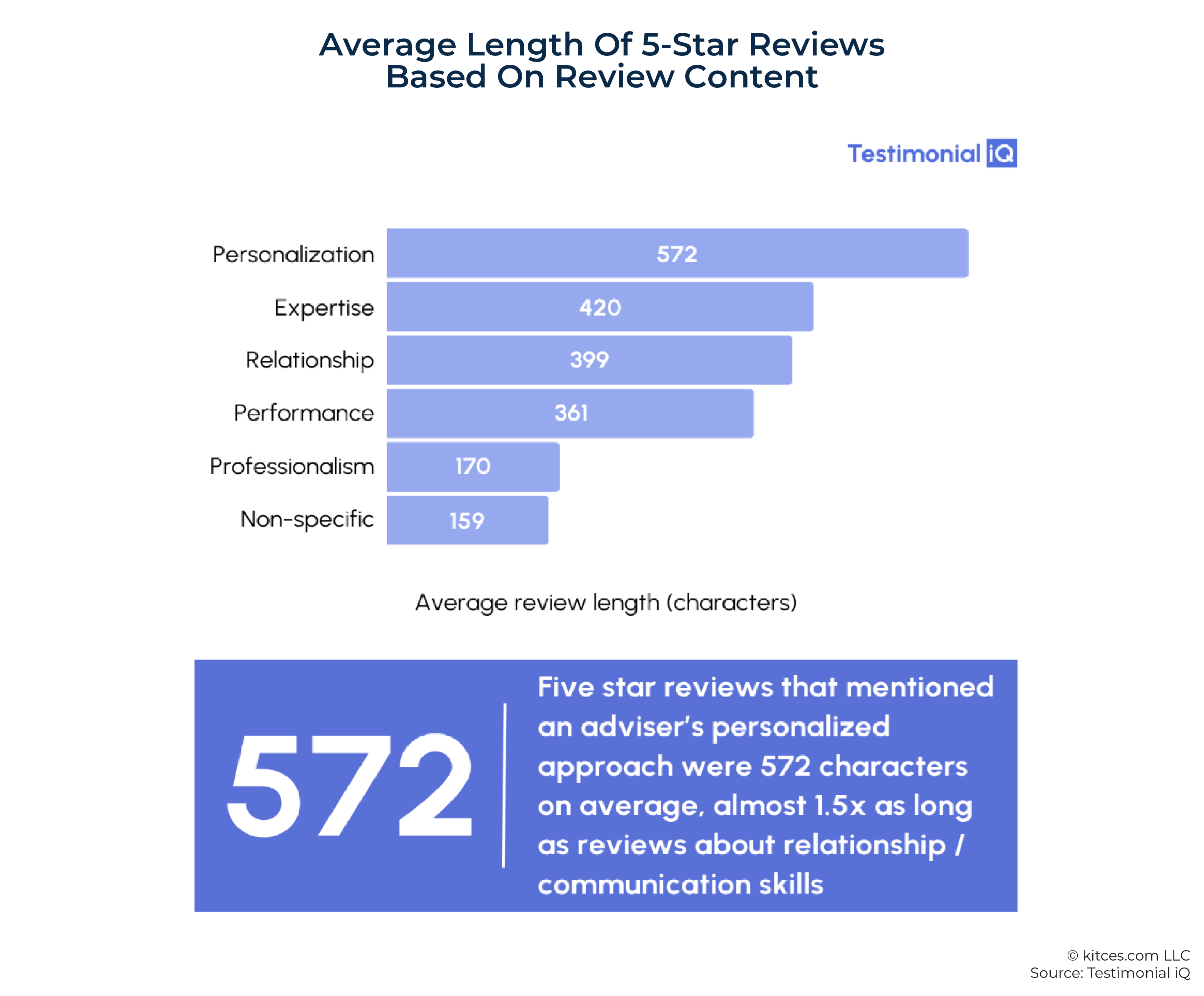



Leave a Reply